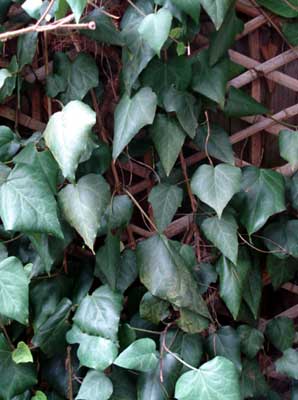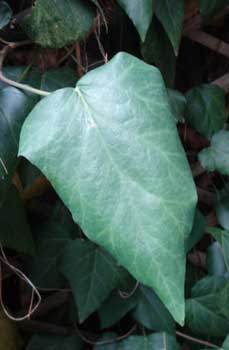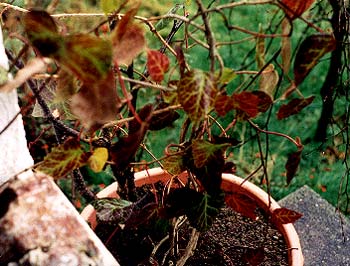
Algerian Ivy; aka:
Canary Island Ivy,
North African Ivy,
or Madeira Ivy
"I give to thee great gardens,
with trees & vines in the temple of Atuma."
-Rameses III
(about 1155 BCE)
(about 1155 BCE)
 In some parts of the country Algerian Ivy has proven to be invasive, but on Puget Sound it is restrained. It thrives in warm climates, being native of scorching Algeria, Tunisia, Portugal, the Azores, & the Canary Islands.
In some parts of the country Algerian Ivy has proven to be invasive, but on Puget Sound it is restrained. It thrives in warm climates, being native of scorching Algeria, Tunisia, Portugal, the Azores, & the Canary Islands.It is not cold hardy, suffering damage at 10 to 20 degrees F., which for our region is on the cusp of its acceptable range. It can sometimes require spring trimming to rid it of leaves that weathered the winter poorly, but we have so very few winter days into the 20s, there's really not any damage. The cold actually seems to do it good from the point of view of not wanting it to spread invasively or choke out nearby plants the way regular English ivy does.
Its evergreen leaves are unusually large, six to eight inches on average. For this reason it has sometimes been called Big Leaf Ivy or even Elephant Leaf Ivy, though its name seems largely by now to have nearly standardized as Algerian Ivy.
The big leaves become bright bronzy red in some winters, then green again in spring & summer. Ours did this years ago when we had it in a pot (last photo below, February 2002) & its roots were chilled in winter. But after we put it in the ground, we never saw it turn red again, which was kind of a loss as we liked that.
 When I decided to put it in the ground, I had a devil of a time unwinding it from a roofgutter down-spout, where it had begun to wind its way up the wall. It was planted at the base of a big trellis, where it got less sun & full protection against cold & wind, so it remained completely green through winter. It took a few years but eventually it filled up the trellis, & sent trailing vines as across the garden, over twenty feet when not trimmed back to the trellis. Fortunately these long questing vines snip away very easily removed.
When I decided to put it in the ground, I had a devil of a time unwinding it from a roofgutter down-spout, where it had begun to wind its way up the wall. It was planted at the base of a big trellis, where it got less sun & full protection against cold & wind, so it remained completely green through winter. It took a few years but eventually it filled up the trellis, & sent trailing vines as across the garden, over twenty feet when not trimmed back to the trellis. Fortunately these long questing vines snip away very easily removed.Broadly speaking it is not picky as to sun conditions, doing well in full sun or full shade. When in shade, rainfall provides sufficient water, since it would prefer a slightly drier soil than is the natural average around here. It's not as thoroughly drought-hardy as English ivy however, & in full sun might need occasional watering.
It grows well as a groundcover, but is also a vigorous climbing vine. After only once being laid into the trellis, clinging with its own aerial roots. It's a slow grower at first but after a few years becomes more vigorous, though in our climate never as aggressive as English ivy.
See also:
'Glore de Marengo' Variegated Algerian Ivy